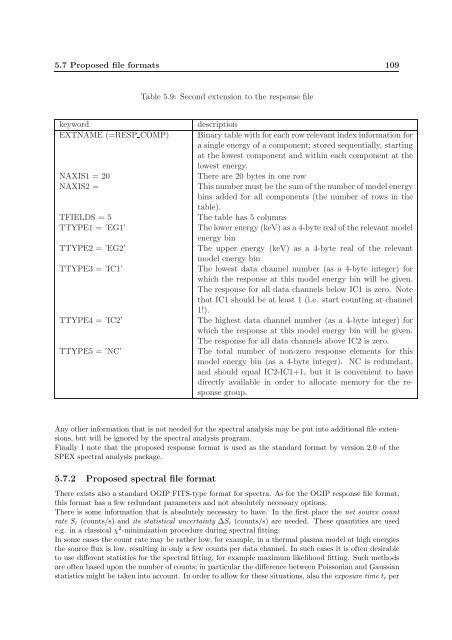SPEX User's Manual - SRON
SPEX User's Manual - SRON
SPEX User's Manual - SRON
You also want an ePaper? Increase the reach of your titles
YUMPU automatically turns print PDFs into web optimized ePapers that Google loves.
5.7 Proposed file formats 109<br />
Table 5.9: Second extension to the response file<br />
keyword<br />
EXTNAME (=RESP COMP)<br />
NAXIS1 = 20<br />
NAXIS2 =<br />
TFIELDS = 5<br />
TTYPE1 = ’EG1’<br />
TTYPE2 = ’EG2’<br />
TTYPE3 = ’IC1’<br />
TTYPE4 = ’IC2’<br />
TTYPE5 = ’NC’<br />
description<br />
Binary table with for each row relevant index information for<br />
a single energy of a component; stored sequentially, starting<br />
at the lowest component and within each component at the<br />
lowest energy.<br />
There are 20 bytes in one row<br />
This number must be the sum of the number of model energy<br />
bins added for all components (the number of rows in the<br />
table).<br />
The table has 5 columns<br />
The lower energy (keV) as a 4-byte real of the relevant model<br />
energy bin<br />
The upper energy (keV) as a 4-byte real of the relevant<br />
model energy bin<br />
The lowest data channel number (as a 4-byte integer) for<br />
which the response at this model energy bin will be given.<br />
The response for all data channels below IC1 is zero. Note<br />
that IC1 should be at least 1 (i.e. start counting at channel<br />
1!).<br />
The highest data channel number (as a 4-byte integer) for<br />
which the response at this model energy bin will be given.<br />
The response for all data channels above IC2 is zero.<br />
The total number of non-zero response elements for this<br />
model energy bin (as a 4-byte integer). NC is redundant,<br />
and should equal IC2-IC1+1, but it is convenient to have<br />
directly available in order to allocate memory for the response<br />
group.<br />
Any other information that is not needed for the spectral analysis may be put into additional file extensions,<br />
but will be ignored by the spectral analysis program.<br />
Finally I note that the proposed response format is used as the standard format by version 2.0 of the<br />
<strong>SPEX</strong> spectral analysis package.<br />
5.7.2 Proposed spectral file format<br />
There exists also a standard OGIP FITS-type format for spectra. As for the OGIP response file format,<br />
this format has a few redundant parameters and not absolutely necessary options.<br />
There is some information that is absolutely necessary to have. In the first place the net source count<br />
rate S i (counts/s) and its statistical uncertainty ∆S i (counts/s) are needed. These quantities are used<br />
e.g. in a classical χ 2 -minimization procedure during spectral fitting.<br />
In some cases the count rate may be rather low; for example, in a thermal plasma model at high energies<br />
the source flux is low, resulting in only a few counts per data channel. In such cases it is often desirable<br />
to use different statistics for the spectral fitting, for example maximum likelihood fitting. Such methods<br />
are often based upon the number of counts; in particular the difference between Poissonian and Gaussian<br />
statistics might be taken into account. In order to allow for these situations, also the exposure time t i per

















